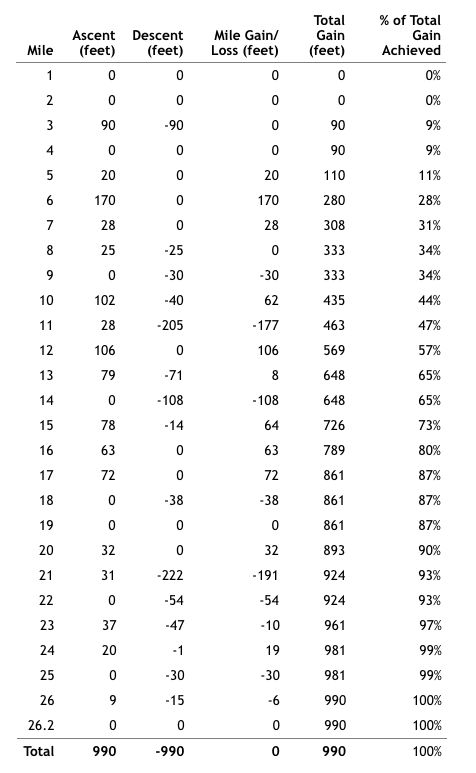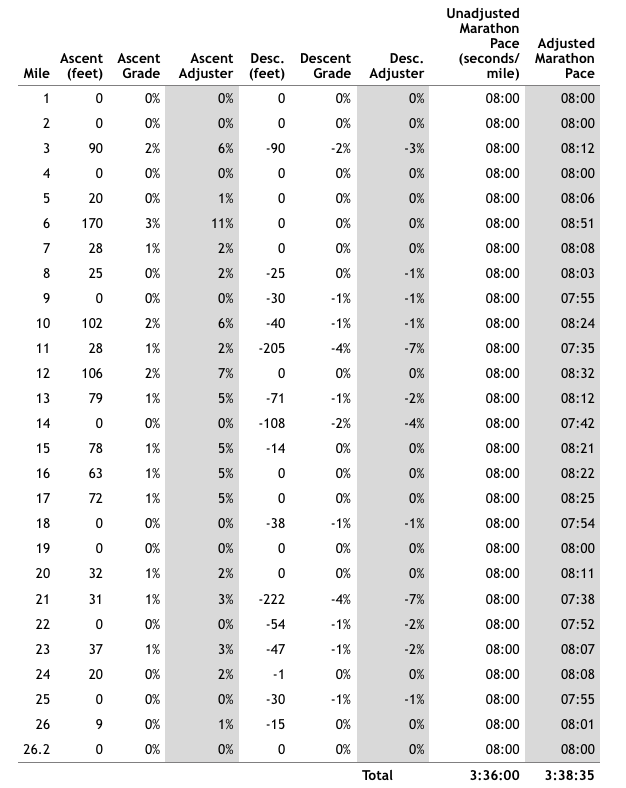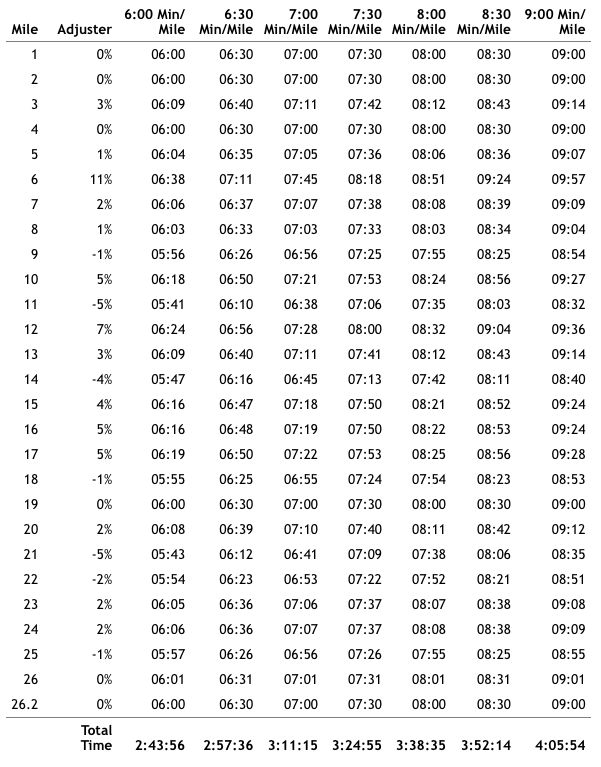The Biofreeze San Francisco Marathon and Elevation Pacing
“It seemed like a matter of minutes when we began rolling in the foothills before Oakland and suddenly reached a height and saw stretched out ahead of us the fabulous white city of San Francisco on her eleven mystic hills with the blue Pacific and its advancing wall of potato-patch fog beyond, and smoke and goldenness in the late afternoon of time.” — Jack Kerouac, On the Road
Much of San Francisco’s beauty comes from its hills. The city clings to the steeply falling walls of the Presidio, which wall it off from the churning Pacific to the West and the muddy bay to the East. These hills make for a hillier marathon- the total elevation gain for the SF Marathon is about 990 feet, with a corresponding loss of 990 feet, for a net elevation change of zero (unofficial- recorded using my own GPS). This is much hillier than the California International Marathon in Sacramento (gain 242, descent 552 for a net loss of 309 feet) and Boston (gain 544, loss 922, net loss of 378), but much less hilly than the Big Sur International Marathon (gain 1,660, loss 1,958, net descent of 298).
Even planning your pace for a relatively flat marathon can be difficult- how do you plan a consistent pace when you’re going to be running up and down several hills? The purpose of this post is to help you estimate your finishing time based on the elevation of the marathon, then use a mile by mile breakdown of the SF Marathon course to help you come up with a pace plan that works for you.
Planning your expected SF Marathon Time
Let’s start by assuming you’ve run a flatter marathon or that you have a generic time goal for a flat marathon. For this analysis, we’re going to use a time for a flat marathon of 3:36 (8 min/mile pace). Then, we’re going to use John Kellogg’s pace plan for elevation. Kellogg is a runner and trainer legendary for the depth and breadth of his posting on www.letsrun.com. A collection of his writing is here. Although this will differ for every runner based on their natural abilities and state of training, John estimates 10 feet of elevation gain will add 1.74 seconds to a running time- regardless of the distance covered. At 990 feet of gain x 1.74 seconds added for each 10 feet of gain, we get a total addition to your pace of 2 minutes, 52 seconds. So, if I run a 3:36 marathon with no elevation change, I can expect to finish SF in about 3:38:52.
Elevation Breakdown of the SF Marathon
Yes- the SF Marathon is hilly. But these hills are not uniformly distributed across the course. The first and last two miles are almost perfectly flat. A mile by mile breakdown of the marathon is below. Please note- these elevation changes were recorded using personal GPS and are unofficial- your measurements may change. Running data for this marathon is on Strava if you’d care to see it.
We’ve taken each mile of the race (1st column) and listed the feet of climb (2nd column) and the feet of descent (3rd column). Adding them together produces the total gain/loss for that mile (4th column). Because climbing is more difficult than descending, we’ve listed the total climb up to that point in feet (5th column), and as a percentage of the total gain of the race (6th and final column).
Table A: Elevation Gain/Loss in the SF Marathon, by Mile
Source: Author’s GPS
A few points on overall race topography:
- The first half of the marathon is much hillier than the second. 65% of the total climb in this race is in the first 13 miles
- The first half of the marathon generally gains elevation (net gain of 187 feet), while the second half of the marathon generally loses elevation (net loss of 187 feet)
- Over 1/3 of the elevation gains in the marathon are on just three separate miles- mile 6 (when the race heads up onto the Golden Gate Bridge), mile 10 (climbing the Presidio), and mile 12 (leaving the Presidio and running up 27th Avenue towards Golden Gate Park)
Planning your Pace Around the SF Marathon’s Hills
To determine a pace over each of these mile segments, we’re going to use some rules of thumb developed by Dr. Mervyn Davies, referenced in Tim Noakes’ book “Lore of Running,” and accessed from Greg Maclin’s running calculator at www.mymarathonpace.com. We’re going to use six rules of thumb for calculating the pace you need for each mile:
Miles 1-16
- Every 1% of upgrade slows your pace 3.3%
- Every 1% of downgrade speeds your pace 1.8%
Miles 16-21
- Every 1% of upgrade slows your pace 3.8%
- Every 1% of downgrade speeds your pace by 1.8%
Miles 21-26.2
- Every 1% of upgrade slows your pace 4.3%
- Every 1% of downgrade speeds your pace by 1.7%
This will necessarily be broad- but we’re going to apply these rules on a mile by mile basis using the data from above. In the table below we’ve taken each mile of the marathon and used the feet of ascent/descent to calculate a total Ascent/Descent grade for that mile. We’ve then taken the Ascent/Descent grade and multiplied it by the adjusters above. This gives us an adjusted pace for each mile.
Table B: SF Marathon Grade % and Ascent/Descent Pace Adjusters by Mile
Source: Author’s data and www.mymarathonpace.com
The table above gives us a marathon adjusted pace of 3:38:35- two minute and 35 seconds above our “flat” goal of 3:36:00. This doesn’t exactly correspond with our previous estimated time of 3:38:52 above, mainly because we averaged elevation mile per mile and combined ascents and descents, rather than actually looking at the grade of the marathon foot by foot (but it is close).
Below we’ve provided the overall percentages to multiple your pace to get a calculation for each mile of the marathon. We’ve also provided a series of sample paces with the adjusted mileage paces provided.
A few takeaways:
-Yes, the SF Marathon is hilly, but no, the hills themselves will not have a dramatic effect on your overall performance. The 2.5 minutes added in the 8:00 min/mile represent a 1% adjustment to overall time
-Not factoring hills into your pacing and coming out the gate too strong, however, can have a tremendous effect on your performance! Most of the elevation gains in this marathon are in the first 12 miles, when many runners are experiencing adrenaline surges and are running too fast anyways. This can lead to severe bonks in the second half of the race
-Runners doing the 1st half marathon will have a net elevation increase of about 190 feet, while runners doing the 2nd half marathon will have a net decrease of about 190. The overall hilliness on the first half is much higher than the second, however, so times will most likely be much faster for runners of the second half
-When training, be sure to train at a marathon pace a few seconds below what you would train on a flat course to compensate for the effect elevation will have on your total performance
Good luck out there!
Andrew Jensen (Twitter: @ca_wave)
Table C: Mile Adjuster and Sample Paces, by Mile
Source: Author’s data and www.mymarathonpace.com





